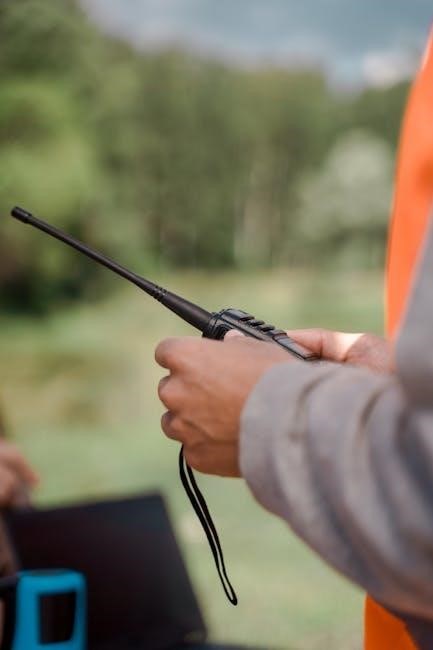The MEE Bluetooth Transmitter is a versatile wireless audio solution designed to stream high-quality sound from devices to Bluetooth headphones or speakers․ It supports dual-device connections, aptX technology, and is compatible with various audio sources, making it ideal for enhancing your audio experience․
1․1 Overview of the MEE Bluetooth Transmitter

The MEE Bluetooth Transmitter is a cutting-edge wireless audio solution designed to enhance your listening experience․ It enables seamless streaming of high-quality sound from various audio sources to Bluetooth-enabled headphones or speakers․ With advanced features like dual-device connection and aptX technology, it ensures low latency and superior audio fidelity․ Compact and user-friendly, the transmitter is compatible with TVs, computers, and other devices, making it ideal for home entertainment, travel, or professional use․ Its versatility and robust performance make it a reliable choice for audiophiles and casual listeners alike, delivering Music Enjoyment for Everyone as promised by MEE audio․
1․2 Key Features of the MEE Bluetooth Transmitter
The MEE Bluetooth Transmitter boasts an array of impressive features that set it apart․ It supports dual-device connection, allowing simultaneous pairing with two Bluetooth headphones or speakers․ Equipped with aptX and aptX Low Latency technology, it ensures high-fidelity audio with minimal delay, perfect for movies and music․ The transmitter is compatible with various audio inputs, including optical, RCA, and 3․5mm, making it versatile for different devices․ Its long-range Bluetooth connectivity provides a stable signal, and the built-in battery offers extended use on the go․ Additionally, it features volume control and audio optimization options, enhancing user convenience․ These features collectively make the MEE Bluetooth Transmitter a powerful tool for elevating your wireless audio experience․

System Requirements and Compatibility
The MEE Bluetooth Transmitter is compatible with Bluetooth-enabled devices, supporting optical, RCA, and 3․5mm audio inputs․ It works seamlessly with TVs, headphones, and speakers, ensuring versatile connectivity․
2․1 Compatible Devices for the MEE Bluetooth Transmitter
The MEE Bluetooth Transmitter is designed to work with a wide range of devices, including Bluetooth headphones, speakers, and non-Bluetooth audio equipment․ It is compatible with TVs, home stereos, and in-flight entertainment systems, making it a versatile solution for wireless audio streaming․ The transmitter supports aptX and aptX Low Latency codecs, ensuring high-quality sound with minimal delay․ It can connect to devices via optical, RCA, or 3․5mm audio inputs, providing flexibility for different setups․ Whether you’re using wireless earbuds, soundbars, or traditional speakers, the MEE Bluetooth Transmitter seamlessly integrates with your audio system, enhancing your listening experience․
2․2 Supported Bluetooth Versions and Profiles
The MEE Bluetooth Transmitter supports advanced Bluetooth versions and profiles, ensuring reliable and high-quality wireless audio streaming․ It operates on Bluetooth 5․3, offering enhanced range and stability․ The transmitter is compatible with popular audio codecs such as SBC, aptX, and aptX Low Latency, which minimize audio delay and provide superior sound quality․ Additionally, it supports A2DP, AVRCP, and HFP profiles, enabling seamless audio streaming, remote control functionality, and hands-free calling․ These features make the MEE Bluetooth Transmitter ideal for use with modern Bluetooth headphones, speakers, and earbuds, delivering an optimal wireless audio experience across various devices and applications․

Setting Up the MEE Bluetooth Transmitter
Setting up the MEE Bluetooth Transmitter involves unboxing, connecting to your audio source, pairing with Bluetooth devices, and configuring settings for optimal performance and convenience․
3․1 Unboxing and Physical Overview
Upon unboxing the MEE Bluetooth Transmitter, you’ll find the device itself, a USB charging cable, and an optical audio cable․ The transmitter is compact and lightweight, designed for easy placement․ On the front, there’s a 3․5mm audio jack, while the back features optical and RCA inputs for versatile connectivity․ The top side includes a power button and a pairing button, with LED indicators showing power and pairing status․ The device is built with durable materials, ensuring long-term reliability․ The included cables cater to different audio sources, making it compatible with TVs, stereos, and more․ The overall design emphasizes simplicity and user-friendliness, allowing seamless integration into your audio setup․

3․2 Connecting the Transmitter to Your Audio Source
To connect the MEE Bluetooth Transmitter to your audio source, start by identifying the appropriate input․ The transmitter supports multiple connection methods, including a 3․5mm audio jack, optical (TOSLINK), and RCA inputs․ For optical connections, ensure your device has an optical output and use the provided optical cable․ For RCA connections, plug the RCA adapter into the transmitter and connect it to your device’s RCA outputs․ The 3․5mm jack is ideal for direct connections to TVs, stereos, or in-flight entertainment systems․ Once connected, ensure the transmitter is powered on and properly configured․ For TVs, verify that the audio output settings are set to PCM or STEREO mode for optimal performance․ This ensures a stable and high-quality audio connection for your Bluetooth headphones or speakers․
3․3 Pairing the Transmitter with Bluetooth Headphones
To connect the MEE Bluetooth Transmitter to your audio source, start by identifying the appropriate input․ The transmitter supports multiple connection methods, including a 3․5mm audio jack, optical (TOSLINK), and RCA inputs․ For optical connections, ensure your device has an optical output and use the provided optical cable․ For RCA connections, plug the RCA adapter into the transmitter and connect it to your device’s RCA outputs․ The 3․5mm jack is ideal for direct connections to TVs, stereos, or in-flight entertainment systems․ Once connected, ensure the transmitter is powered on and properly configured․ For TVs, verify that the audio output settings are set to PCM or STEREO mode for optimal performance․ This ensures a stable and high-quality audio connection for your Bluetooth headphones or speakers․
3;4 Configuring Audio Input Settings
Configuring audio input settings on the MEE Bluetooth Transmitter ensures optimal sound quality․ For optical connections, set your TV’s audio output to PCM or STEREO mode to avoid issues with surround sound formats․ If using RCA, enable VARIABLE audio output in your TV’s settings to ensure proper signal transmission․ For 3․5mm connections, adjust the TV’s volume before plugging in the transmitter, as some devices may lock volume control․ Ensure no other devices are connected to the transmitter’s 3․5mm input to avoid interference․ If using aptX or aptX Low Latency, confirm your headphones support these codecs for reduced lag․ Properly configuring these settings ensures a stable and high-quality audio connection for an enhanced listening experience․
Troubleshooting Common Issues
Resolve issues like no sound, connectivity problems, or audio lag by checking connections, resetting the transmitter, or ensuring aptX compatibility․ Resetting often fixes persistent problems․
4․1 No Sound or Audio Dropouts
Experiencing no sound or audio dropouts with the MEE Bluetooth Transmitter can be frustrating․ Common causes include loose connections, incorrect audio settings, or interference․ First, ensure all cables are securely plugged in and the correct input is selected on your audio source․ If using an optical connection, verify that the TV’s audio output is set to STEREO or PCM, as other settings like Dolby may not work․ For RCA connections, check that the TV’s audio output is enabled and set to VARIABLE․ If using a headphone jack, adjust the volume on both the TV and headphones․ Resetting the transmitter by holding the pairing button until the blue light stops flashing can also resolve issues․ Additionally, minimize interference from nearby devices and ensure stable power supply to the transmitter․
4․2 Connectivity Problems and Pairing Issues

Connectivity problems and pairing issues with the MEE Bluetooth Transmitter can occur due to improper pairing procedures or device incompatibility․ Ensure your Bluetooth headphones or speakers are in pairing mode and within 1 meter of the transmitter․ Verify that the transmitter is properly connected to your audio source and powered on․ If pairing fails, reset the transmitter by holding the pairing button until the blue light stops flashing, then retry․ Check that your devices support the same Bluetooth profiles and codecs․ Interference from nearby devices may also disrupt connections․ If issues persist, consult the user manual for specific pairing instructions or contact MEE audio support for assistance․ Regularly updating your devices’ firmware can also help resolve connectivity problems․
4․3 Audio Lag and Latency
Audio lag and latency when using the MEE Bluetooth Transmitter are typically caused by the digital signal processing required for Bluetooth transmission․ The transmitter supports aptX and aptX Low Latency codecs, which minimize delay compared to standard Bluetooth audio․ To reduce lag, ensure your headphones or speakers support these codecs; If using the transmitter with a TV, check the audio output settings and set them to PCM or Stereo to avoid unnecessary processing․ Additionally, ensure the transmitter is updated with the latest firmware․ For optimal performance, keep devices within a clear line of sight to maintain a stable connection․ If latency persists, resetting the transmitter or pairing it again may resolve the issue․ Using aptX Low Latency-enabled devices is highly recommended for the best audio synchronization․
4․4 Resetting the Transmitter
Resetting the MEE Bluetooth Transmitter can resolve connectivity issues or prepare it for a fresh pairing․ To reset, locate the button marked “A” on the right side of the device․ Press and hold this button until the blue light stops flashing, which typically takes about 6 seconds․ This action will clear all previously paired devices from the transmitter’s memory․ After resetting, you will need to re-pair any devices you wish to use with the transmitter․ Resetting is a useful troubleshooting step for addressing persistent connectivity problems or starting with a clean configuration․ Ensure the transmitter is powered on and in range of your devices during the pairing process․ This simple procedure helps restore the transmitter to its default settings for optimal performance․

Advanced Features and Settings
The MEE Bluetooth Transmitter offers dual-device connection, aptX and aptX Low Latency support for high-fidelity audio, and volume control for enhanced listening experiences․
5․1 Dual Device Connection Capability
The MEE Bluetooth Transmitter supports dual-device connections, allowing users to pair two Bluetooth headphones or speakers simultaneously․ This feature enhances convenience for shared listening experiences, ensuring both devices receive high-quality stereo audio․ The transmitter automatically balances the connection, maintaining stable playback without dropouts․ It is compatible with a wide range of Bluetooth-enabled devices, including truly wireless earbuds․ For optimal performance, the transmitter supports aptX and aptX Low Latency codecs, reducing audio delay․ Users can seamlessly switch between devices or enjoy synchronized audio with friends․ This capability makes it ideal for home theaters, gaming, or traveling, providing flexibility and versatility for various audio setups․ The dual-device feature is easy to configure and ensures a smooth, uninterrupted listening experience for all connected devices․
5․2 Volume Control and Audio Optimization
The MEE Bluetooth Transmitter offers intuitive volume control and audio optimization features to enhance your listening experience․ Users can adjust the volume directly on their connected Bluetooth headphones or speakers, ensuring seamless control․ For devices like AirPods, volume adjustments can be made through the paired iPhone or iPad․ The transmitter supports advanced audio codecs, including aptX and aptX Low Latency, which optimize sound quality and minimize lag․ Additionally, the device allows for balanced audio output, ensuring clear and high-fidelity sound․ The transmitter also supports both analog and digital audio inputs, providing flexibility for various audio sources․ These features make it easy to customize and optimize your audio settings for a superior listening experience, whether streaming music, watching movies, or gaming․
5․3 Using the Transmitter with aptX and aptX Low Latency
The MEE Bluetooth Transmitter supports aptX and aptX Low Latency codecs, enabling high-fidelity audio with reduced delay․ These codecs compress audio files without losing quality, ensuring a seamless listening experience․ aptX Low Latency is particularly beneficial for video content, synchronizing audio with visuals more effectively․ To maximize these features, pair the transmitter with headphones that support aptX or aptX Low Latency․ The MEE Matrix Cinema headphones are recommended for optimal performance․ While the transmitter supports these advanced codecs, the actual latency reduction depends on the connected headphones’ capabilities․ This feature makes the MEE Bluetooth Transmitter ideal for applications requiring precise audio synchronization, such as gaming or watching movies, delivering a more immersive experience․
Frequently Asked Questions
Q: How many devices can connect to the MEE Bluetooth Transmitter? Up to two Bluetooth headphones or speakers can be connected simultaneously for a seamless audio experience․
Q: Does it support aptX Low Latency? Yes, it supports aptX and aptX Low Latency, reducing audio delay for synchronized sound with visuals․
Q: Is WiFi required for operation? No, the transmitter operates via Bluetooth, eliminating the need for WiFi connectivity․
6․1 Can I Connect Multiple Bluetooth Speakers?
The MEE Bluetooth Transmitter supports connecting up to two Bluetooth speakers simultaneously, enabling a shared audio experience․ Both speakers will receive the same stereo signal, meaning they cannot be split into separate left and right channels unless the speakers themselves support such functionality․ This feature is ideal for creating a multi-room setup or sharing audio with another listener․ To connect multiple speakers, ensure they are in pairing mode and follow the transmitter’s pairing process․ Note that audio latency may vary depending on the speakers’ compatibility with aptX or aptX Low Latency codecs․ For optimal performance, ensure your speakers support these codecs to minimize synchronization issues․
6․2 Is the Transmitter Compatible with Truly Wireless Earbuds?
The MEE Bluetooth Transmitter is fully compatible with Bluetooth-enabled truly wireless earbuds, allowing users to enjoy high-quality audio streaming․ To ensure optimal performance, it is recommended to use earbuds that support aptX or aptX Low Latency codecs for reduced audio lag․ While the transmitter works seamlessly with most wireless earbuds, including popular brands like AirPods, some features like volume control may require additional steps․ For instance, adjusting volume on AirPods requires connecting them to a paired iPhone or iPad first․ Overall, the transmitter provides a reliable and convenient way to connect wireless earbuds to non-Bluetooth audio sources, enhancing your listening experience with minimal setup and hassle․

6․3 How to Adjust Volume with AirPods
Adjusting the volume with AirPods when using the MEE Bluetooth Transmitter requires a simple workaround․ Since AirPods do not have built-in volume controls, you must adjust the volume through your connected device․ To do this, pair your AirPods with your iPhone or iPad, then increase or decrease the volume using the device’s volume controls or the Control Center․ Once the desired volume is set, pair the AirPods back with the MEE Bluetooth Transmitter․ This ensures the volume level is maintained during your listening experience․ While this method is effective, it is recommended to use headphones with dedicated volume controls for easier adjustments directly from the headphones․
6․4 Can I Use the Transmitter as a Receiver?
The MEE Bluetooth Transmitter is specifically designed to function as a transmitter, not a receiver․ It streams audio from a connected source, such as a TV or computer, to Bluetooth headphones or speakers․ If you want to use it as a receiver to stream music from your phone to a non-Bluetooth device, it is not supported․ For this purpose, you would need a separate Bluetooth receiver, such as the MEE Connect Hub․ The transmitter’s primary function is to send audio wirelessly, making it ideal for enhancing your listening experience with compatible devices․ For receiving audio, consider a dedicated receiver model designed for that purpose․
6․5 Do I Need WiFi to Use the Transmitter?
No, you do not need WiFi to use the MEE Bluetooth Transmitter․ It operates using Bluetooth technology, which connects directly to your audio source and headphones or speakers․ WiFi connectivity is unnecessary for its core functionality․ The transmitter streams audio wirelessly via Bluetooth, eliminating the need for internet access․ However, ensure your devices are properly paired and within range for optimal performance․ WiFi is only required if you plan to access additional features or updates through the manufacturer’s app or website, but this is not essential for basic operation․ The transmitter is designed to provide a seamless, wireless audio experience without relying on internet connectivity․

6․6 Power Requirements and Battery Life
The MEE Bluetooth Transmitter requires a USB power source for operation․ It is recommended to keep it plugged in during use to ensure uninterrupted audio streaming․ The transmitter features a built-in battery that provides up to 12 hours of playtime on a single charge․ For optimal performance, charge the device using a standard USB charger․ The transmitter does not automatically power off while plugged in, allowing it to remain ready for use at all times․ Battery life may vary depending on usage patterns and audio settings․ Regular charging ensures consistent performance and reliability․ Always use the provided or a compatible USB cable for charging to maintain the device’s functionality and longevity․
The MEE Bluetooth Transmitter offers a seamless wireless audio experience with robust features and compatibility․ For further assistance, visit the official MEE audio website or consult the user manual for detailed support and troubleshooting guides;
7․1 Final Thoughts on the MEE Bluetooth Transmitter
The MEE Bluetooth Transmitter is a versatile and reliable solution for wireless audio streaming, offering seamless connectivity and high-quality sound․ Its dual-device connection capability, aptX support, and compatibility with various audio sources make it ideal for enhancing your audio experience․ Whether you’re using it with TVs, home stereos, or on-the-go devices, the transmitter delivers consistent performance․ The user-friendly design and comprehensive manual ensure easy setup and troubleshooting․ With its advanced features and robust compatibility, the MEE Bluetooth Transmitter is a great choice for anyone looking to upgrade their audio setup․ Its ability to minimize latency and provide clear sound makes it a standout option for both casual listeners and audiophiles alike․

7․2 Where to Find More Information and Support
For more information and support regarding the MEE Bluetooth Transmitter, visit the official MEE audio website at MEEaudio․com․ Here, you can access detailed product specifications, user manuals, and troubleshooting guides․ Additionally, the site offers instructional videos and FAQs to help you get the most out of your device․ If you encounter any issues or have specific questions, contact MEE audio’s support team directly through their website․ They provide comprehensive assistance to ensure your experience with the transmitter is smooth and enjoyable․ You can also download the PDF manual from the site or refer to the legacy user manuals section for older models․ MEE audio is committed to delivering exceptional support to enhance your wireless audio experience․
